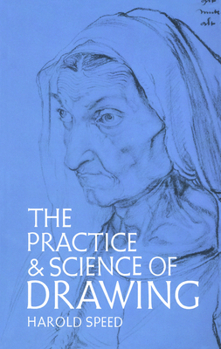The Practice and Science of Drawing
Select Format
Select Condition 
Book Overview
Much of the learning to practice as well as to appreciate art is concerned with understanding the basic principles. One of these principles is what Harold Speed calls "dither," the freedom that allows realism and the artistic vision to play against each other. Very important to any artist or work of art, this quality separates the scientifically accurate from the artistically accurate. Speed's approach to this problem is now considered a classic, one of the few books from the early years of this century that has continued to be read and recommended by those in the graphic arts. In this work, Harold Speed approaches this dynamic aspect of drawing and painting from many different points of view. He plays the historical against the scientific, theory against precise artistic definition. He begins with a study of line drawing and mass drawing, the two basic approaches the artist needs to learn. Further sections carry the artistic vision through unity and variety of line and mass, balance, proportion, portrait drawing, the visual memory, materials, and procedures. Throughout, Speed combines historical backgrounds, dynamic aspects which each technique brings to a work of art, and specific exercises through which the young draughtsman may begin his training. Although not a technique book in the strict sense of the terms, The Practice and Science of Drawing brings to the beginner a clear statement of the principles that he will have to develop and their importance in creating a work of art. Ninety-three plates and diagrams, masterfully selected, reinforce Speed's always clear presentation. Harold Speed, master of the art of drawing and brilliant teacher, has long been cited for this important work. For the beginner, Speed will develop a sense for the many different aspects which go into an artistic education. For the person who enjoys looking at drawings and paintings, Speed will aid developing the ability to see a work of art as the artist meant it to be seen.
Format:Paperback
Language:English
ISBN:0486228703
ISBN13:9780486228709
Release Date:June 1972
Publisher:Dover Publications
Length:400 Pages
Weight:1.06 lbs.
Dimensions:1.0" x 5.5" x 8.4"
Customer Reviews
4 ratings
The Best Book on Drawing (theory)... Period.
Published by Thriftbooks.com User , 19 years ago
I'm now a professional illustrator and art director. But for 17 years... from adolescence on, I was a hobbyist... someone who just loved to draw. It was this book, INGENIOUSLY simple and straightforward in both it's presentation and elucidation of "how to see," which brought me from hobbyist, to professional. I learned more from reading this book than from thumbing through any of the other 50+ art-technique books in my collection (this is a book to be read... primarily text, not primarily illustrations). Get this book. If like me, you're self-taught... and you already know how to draw... and are looking to hit the next level, it's invaluable.
the best ever done in English
Published by Thriftbooks.com User , 22 years ago
It's easy to pontificate and very, very hard to draw. Suspiciously absent from most books on drawing are drawings by the author. But Speed, a journeyman painter whose career bridged the 19th and 20th centuries, drew wonderfully well, and his drawings vindicate his ideas. Additionally, Speed's career embodies the best of the academic tradition and the then-contemporary discoveries of the Impressionists. His assessment of Monet has stood the test of time, as have his splendid instruction on the nuts and bolts of drawing. If you can only have one book on drawing -- and I have a vested interest in this area -- Speed's is the one to get.
Brilliant book for any artist
Published by Thriftbooks.com User , 22 years ago
This book is an in depth study on the elements that make a piece of art. It covers the style and movement of line, (both the drawn and implied), mass, tone, rythym, balance and proportion. It also discusses variation and unity within the individual elements, how all the elements work with the subject to create a piece of art and the differences between a piece of art and a great piece of art.I could ramble on, but will not, though there is so much more in this book. It is bursting at the binding with insight on drawing. It is clearly written by someone who obviously knows what he is writing about. It is a fantastic art course by a man who knows how to teach. It is as relevant today as it was when written, probably even more so given my experience of modern art tuition over the years. If you want to be an artist, no, if you want to be a great artist, read this book.
a superb guide to traditional drawing
Published by Thriftbooks.com User , 26 years ago
Though written nearly a hundred years ago, Harold Speed's book is a gem. We live in a time when traditional drawing techniques are hard to come by, but Speed takes us back to the essential skills of the late nineteenth century. If you dream, as I do, of drawing like Ingres and painting like Sargent, this book will point the way. An absolute classic.







